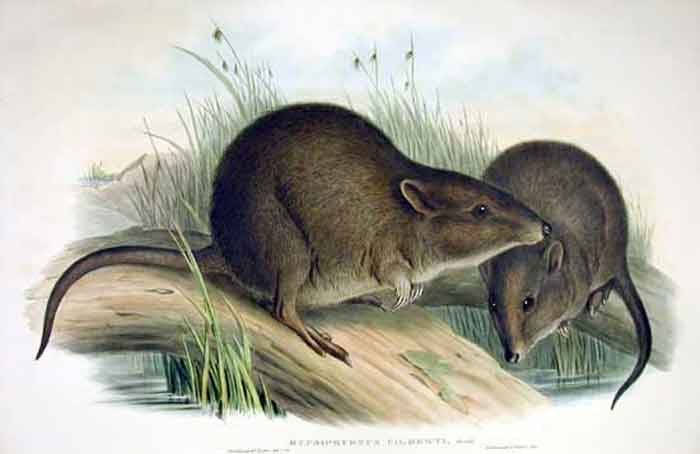Potorous gilbertii Cladus: Eukaryota Name Potorous gilbertii (Gould, 1841) Type locality: Australia, Western Australia, King George Sound Synonyms * Hypsiprymnus gilberti Gould, 1841
References * IUCN link: Potorous gilbertii (Gould, 1841) (Critically Endangered) ------------- Gilbert's Potoroo (Potorous gilbertii) is an Australian marsupial, sometimes called a rat-kangaroo, that is critically endangered. It is described as pointed in the face and about the size of a rabbit.[1] It lives in a restricted area on the southwest coast of Western Australia.[2] Gilbert's Potoroos now exist on Bald Island and are breeding successfully. The population of the Gilbert’s Potoroo is approximated at less than 40 marsupials. This small population size is what has made them be listed as critically endangered.[3] It is one of the world’s rarest mammals.[4]
Gilbert’s potoroo was first discovered 1840 and named in 1841 after the English naturalist and explorer John Gilbert.[5] Gilbert had collected several specimens at King George Sound in Australia, this potoroo being one of them. Gilbert’s potoroo was not seen again for many years, even though many had searched for them in the 1970s. The species was thus considered extinct[6] for 120 years before it was re-discovered in 1994 in Two Peoples Bay Nature Reserve. Liz Sinclair had been doing research on wallabies and caught the potoroo in one of her traps.[7] She then compared her captured specimen with the skeletons of past potoroos and proved that it was indeed, the Gilbert’s Potoroo. Habitat & Diet Potoroos live under dense bushes and shrubs. Potoroos are nocturnal and spend their days hiding under the dense thicket and rarely cross over large areas. Potoroos' diet consists of eating multiple varieties of truffles and fungi.[8] Australia has the majority of different kinds of truffles and Potoroos like to eat a variety of them.[9] Potoroos have sharp three toed claws that help them dig into the ground to unearth truffles hiding underneath the earth’s surface. After digestion, the potoroos aid in spore distribution, as the spores germinate from a potoroo's feces.[10] Reproduction The female potoroos can have two babies in a year, while carrying only one at a time. They have the ability to keep a second embryo in a state of diapause while the first embryo is growing. If the first baby does not go to term, this allows a second baby to start growing right away. It is currently not known how long gestation is for Gilbert’s potoroo, but it is estimated to be similar to the Long-nosed Potoroo’s length of 38 days.[11] Efforts to increase population After the rediscovery of Gilbert’s potoroo, additional specimens were immediately taken into captivity to try to help and promote more young to be born in order to help increase the population. A few young were born in the first couple of years, but then breeding stopped for no known reason. Many studies have been put into effect to analyze the diet, nutrition and environment of the potoroos, but they are still having problems getting the potoroos to breed. In 2001, an action group was formed called the Gilbert’s Potoroo Action Group (GPAG).[12] The group was formed to help in the education and public awareness of the potoroo. The group also helps with raising funds for the research and captive breeding programs for Gilbert’s potoroo. In efforts to protect the remaining population, three potoroos (one male and two females) were translocated to Bald Island in August 2005 where they are free from predation. Since that time an additional four potoroos have been sent to establish a breeding colony. References 1. ^ Coatney, Caryn. "Rare critters in a wild world down under." Christian Science Monitor 89.165 (22 July 1997): 14. Source: Wikispecies, Wikipedia: All text is available under the terms of the GNU Free Documentation License |
|


